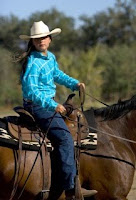 Hi, I’m Brenda Lacey formally Brenda Turner before I met a cowboy, fell in love and moved to a very little town of maybe 500 people called Independence in the Owens Valley on the Eastern Side of the Sierras. I grew up in Ventura, California right on the beach and raised 4-H market lambs in my backyard next to Buena High School and knew I wanted to be an Animal Science pre vet major at Cal Poly. I went to Cal Poly SLO got that degree in Animal Science and stayed to get my teaching credential in Agriculture Science and a Masters. When I got my first job teaching at Exeter High School my parents were ecstatic and I was ready to teach. Along the way I kept in touch with Mark Lacey, now my husband, and in 1992 we decided it was love and had a big wedding in San Luis. We packed the horse trailer full of everything I owned along with two dogs, four cats, one horse and flock of sheep and headed up Highway 395 to Independence.
Hi, I’m Brenda Lacey formally Brenda Turner before I met a cowboy, fell in love and moved to a very little town of maybe 500 people called Independence in the Owens Valley on the Eastern Side of the Sierras. I grew up in Ventura, California right on the beach and raised 4-H market lambs in my backyard next to Buena High School and knew I wanted to be an Animal Science pre vet major at Cal Poly. I went to Cal Poly SLO got that degree in Animal Science and stayed to get my teaching credential in Agriculture Science and a Masters. When I got my first job teaching at Exeter High School my parents were ecstatic and I was ready to teach. Along the way I kept in touch with Mark Lacey, now my husband, and in 1992 we decided it was love and had a big wedding in San Luis. We packed the horse trailer full of everything I owned along with two dogs, four cats, one horse and flock of sheep and headed up Highway 395 to Independence.My friends couldn’t believe it. There was no shopping, no movies, no take out, nothing but mountains and big open spaces. I had to explain it was easier to move me than thousands of cattle so we set up house not far from where Mark’s great grandfather settled in the late 1800’s. We have two wonderful girls, Molly 15 and Katie 11, and they love the ranch. They get to ride their horses, raise lambs, hogs, and rabbits. The girls do terrific in school and participate in ASB, sports, and clubs. They only have 32 students in their whole class; I had over 500, but what a great school Lone Pine has.








I worked for the University of California out of UC Davis up in Bishop for 12 years as the 4-H Program Representative running the 4-H program and then 3 years ago was asked by the Superintendent of School if I would help them keep their FFA program. I love FFA! There isn’t a better organization for high school students anywhere and the chance to help them and build a program was exactly what I needed. I said a sad farewell to 4-H and started teaching at Lone Pine High School as an agriculture teacher. Great students, staff, and a program with just tons of potential. There is a 10 acre school farm and we have built a 50X100 foot barn, put in a beef unit, pastures, landscaping, water and electricity. It is a truly a fantastic facility and one we are all proud of.
Living and working on a ranch is amazing, teaching children about the importance of agriculture is my passion, and raising two children with my cowboy is my life. Writing a blog about ranching and agriculture is scary and exciting at the same time and I’m looking forward to giving you a front row seat.




